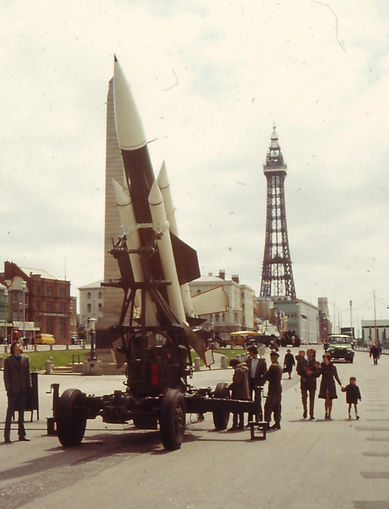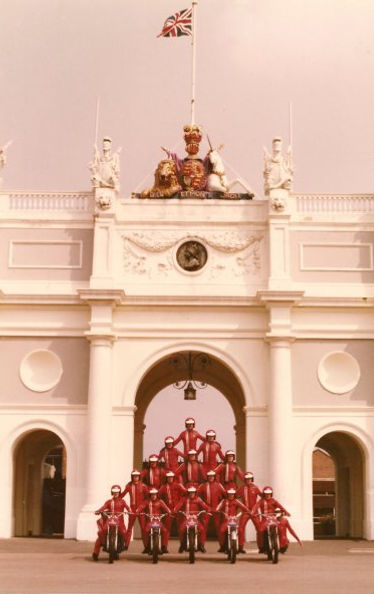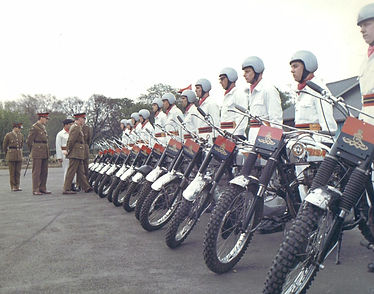




Royal Artillery Recruiting Troop

The Origin's of The RA Recruiting Troop









1961
No1 Display Team
Originally there were three Independant Teams:
The Central Display Team
The RA Motor Cycle Display Team
The Thunderbird Mobile Exhibition
The Thunderbird Mobile Exhibition was a 16 man strong team,
and had the following equipment:
The Display Vehicle: A Thornycroft 'Big T' Tractor, with a converted
Rubery-Owen trailer to show a model of a Deployed SAGW Troop.
Thunderbird 1 Missile and Launcher Loader towed by a
Bedford RL3 ton truck
Thunderbird Launcher towed by a Bedford RL3 ton truck
Bofors 40/70 LAA Gun towed by a AEC Matador 10 ton truck
Meadows 27.5 KVA Generator towed by a Bedford RL3 ton truck
2 x Austin Champs
For a short period the Team were stationed at
Piddlehinton Camp, Dorset, and maintenance of the Missile
was carried out by English Electric in Stevenage.
All members of the Troop had to learn a running commentary
describing the events from the detection to the destruction of
a target. This semi-trailer housed a complete working
simulated model of the radars, height finder, TIR range detector
and launchers, the complete show lasted for 25 minutes.
Memories from Dave Thorpe
RA Central Display Team - The Early Years
I joined the Central Display Team from 16 Regiment RA in
November 1961. I believe the team had been based at Woolwich for
about 12 months. At this time, the Recruiting Troop was in three sections:
1. The RA Motor Cycle Display Team
2. The Thunderbird Team
3. The Central Display Team
If my memory serves me rightly, the OC was a Captain Myers,
with Lt Webster as 2IC. RSM Bob Duncan MM, was our WO1,
Staff Sgt Neville was Troop QM Sgt, and Gnr Bill Blackett
(National Service) was the Troop Clerk.
The Central Team members in 1962 were:
Wo1 Bob Duncan MM
Sgt Paddy Kellaher
L/ Bdr Mick Coulson (7 RHA)
L/Bdr Peter Carroll (4th Regt)
L/Bdr Tony Legonedec (27 or 47 Regt)
L/Bdr John Adams (Chunky) (94 Regt)
L/Bdr Bill Wilkinson (656 Flight AAC)
L/Bdr Bruce Speight (Arty) (1 RHA)
L/Bdr Maurice Makepeace (16 Regt)
L/Bdr David Thorpe (Corky) (16 Regt)
Craftsman Graham Whale (REME)
Following a gunnery course on the 105mm Pack Howitzer, we
travelled all over the UK to various County Shows, TA Halls, Youth
Clubs, in fact anywhere where there were young men and women who
might be interested in the RA as a career. We were based at
Woolwich, along with the rest of the Recruiting Troop. and our
garages/preperation areas were in the Rotunda compound.
Our equipment consisted of a 105mm Pack Howitzer, a Saracen
Armoured Car, a Drone Surveillance Radio Control Aircraft.
Our transport consisted of 4 x 3-ton Bedford RLs, 1 Land Rover,
1 Austin Champ, 1 4-wheeled Caravan for office use, and 1 Jeep
Generator. There were also various small items on show, including
a theodolite. The display consisted of a fabricated frame covered
in canvas, showing lots of still photographs of various Artillery activities.
We also showed films.
To explain the basic workings of the equipment, the troop attended
courses at Larkhill School of Artillery, and at Manorbier
School of Artillery.
1963 saw changes, mainly in personnel. John Adams left, later
to be commissioned I believe. Bruce Speight and Tony Legonedec
moved on. Replacements were Gnr Jock Elder (42 Regt), Gnr Ridley
(Whistler), Gnr "Brummy" Williams (36 Regt).Cpl Madge Kennedy
and 2 Privates from the WRAC, and Tom Britten as our new Tiffy.
HQ also saw changes. Cpt Morgan became OC, Lt Gordon 2IC,
BSM Pat Arbour our WO, and Sgt (Jungle) Jim Taylor replaced
Paddy as our Sgt.
Recruiting venues in 1963 were similar to those visited in 1962.
At the end of 1963 I left the Recruiting Troop to join 12 Regiment in Malaya.
Some memories of 1962/63 include:
A rum ration being issued to us in Manorbier, because it was so cold.
Listening to The Beatles sing " Love Me Do" at the Cavern Club.
Watching as lots of school kids milled around us on Glasgow Green,
and then proceeding to climb all over Tom Canton's Thunderbird,
stuff cinders and muck down the barrel of Dennis Thirkill's L40/70,
and do a similar thing to our 105.
Listening to Mick Coulson doing his impression of "The Big Bopper
" singing "Chantilly Lace".
Pay Days - when wev were in Woolwich - always followed by a couple
of pints in the Queen Vic, with Wally and Doll (Landlord and Landlady).
Mild was only 1/1d per pint (which equates to just over 5p today).
Steak, egg and chips, bread and butter and tea, in Bert's Cafe which
was 3/6d, (18p). Down the hill to The Salutaion, The Mortar,
and The Ordnance pubs. Not forgetting to call back at Bert's for an
egg banjo on the way back to barracks.
The Early Years
The first Display was undertaken in April by 12th LAA Regiment's
KAPE Team in Northern Ireland, then moved to the
Newcastle/Sunderland area. The visits usually were over a four day period,
and always included a Saturday or Sunday. If at an Agricultural or
County Show, the duration would have been for a week at a time.
In May the complete troop traveled to Larkhill to familiarise themselves
with the Weapons and Equipment they would be using, this lasted for
five days, after which the troop moved onto the School of Artillery,
Manorbier where training continued for a further five days,
consisting of in and out of action drills with both Guns and Missile.
Following this the troop returned to Woolwich where for the next three
days they prepared the equipment in readiness for the troop's
first complete display.
The Troop would start touring the week before Easter, and normally
returned to Barracks at the end of September to prepare for
Administration Parade and Display. It was then Block Leave for the Troop.
This was how the Troop operated for the first three years of its existence,
alwayson a temporary basis, before being brought fully into the
Regimental fold.
During my time with the Troop in the early 70's, the Tour of duty
was for two years, but many stayed much longer than that, especially
in the MCDT. Members of the Troop and the MCDT, were drawn from
all of the Regiments of the Royal Artillery, specializing in there own piece
of equipment, but soon becoming conversant with every aspect of
The Royal Regiment.
The RA Recruiting Troop was unique and will probably never be
resurrected, but it forfilled a vital role during its time of activity,
and the men who served in the Troop were proud to travel the
Country and Abroad representing The Royal Artillery.
I am pleased to report that two of the Troop personnel, Barry Sanderson
MCDT, and Ray Suddes of No1 Display, returned later to the
RA Display Troop as RSM in their own right.
The Royal Artillery Parachute Display Team was formed in 1977, the
team was located in the RA Barracks, Woolwich as part of the
RA Display Troop.
The RA Display Troop is still in operation, but with much less
equipment and manpower, but sadly the MCDT disbanded in 2012.
My thanks to Dennis Thirkill
for his memories of those early years.


